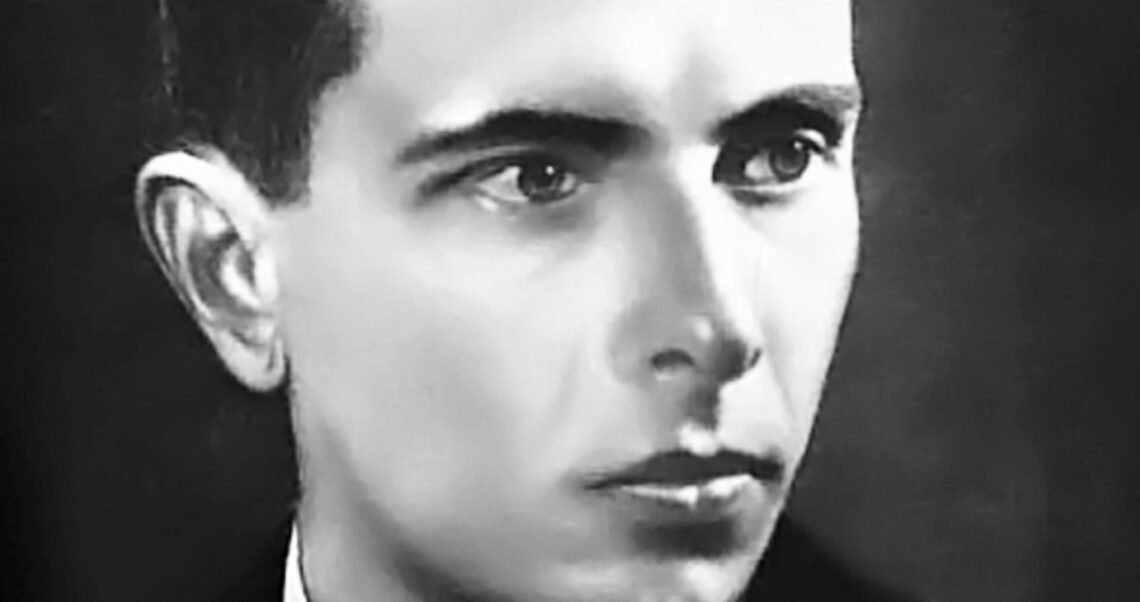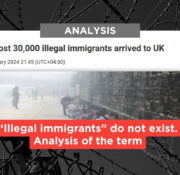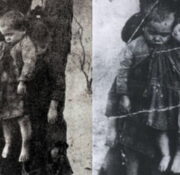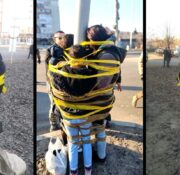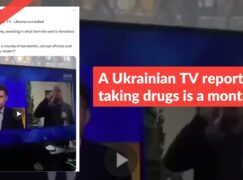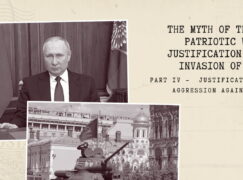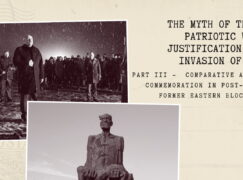One of the main narratives used by the Kremlin to justify the invasion of 24 February was proclaiming Ukraine a Nazi state. According to this narrative, Ukrainian society follows the ideology of the Third Reich, and the underlying figure of the emerging Ukrainian identity is Stepan Bandera. The goal is to authenticate this message, renew ethnic conflicts and antagonize society towards Ukrainians.
By juxtaposing historical events with contemporary references to the activities of Ukrainian nationalists during World War II, the continuity of their ideology is pointed out. The main figure in this narrative is Stepan Bandera and the alleged cult surrounding him. Ukrainian society is described as Banderites, fascists or Nazis.
In this text, we will deconstruct this narrative by analysing it in relation to current social, political, and military events. The first part of the text is devoted to the historical reconstruction of the figure of Stepan Bandera and the Organization of Ukrainian Nationalists. The second part describes the relations of modern Ukrainian society with the symbolic figure of Stepan Bandera. At this point, it should be noted that the process of creating a modern subjectivity of Ukraine as a state should be counted from the Orange Revolution. However, in this text we focused on Ukraine and Ukrainian society after the annexation of Crimea in 2014. Readers interested in historical politics and the topic of building a modern Ukrainian identity before the events of 2014 can explore these analyses of the Centre for Eastern Studies: [1], [2], [3].
Short biography of Stepan Bandera
Stepan Bandera was born on 1 January, 1909 in the village of Staryi Uhryniv in the eastern part of Galicia (now Ivano-Frankivsk Oblast). The Bandera family was actively involved in independence activities in Ukraine. In the period of 1918-1919, his father Andriy took part in the creation of the structures of the West Ukrainian People’s Republic. He was also the chaplain of the troops fighting against Poland. In 1941, he was assassinated in Kyiv by the NKVD. The family of Stepan’s mother also took an active part in the independence movement.
In 1927, Stepan joined the Ukrainian Military Organization, and in 1929, he joined the Organization of Ukrainian Nationalists (OUN). According to the accounts of his colleagues, from the early years Bandera was characterized by fanatical nationalism, extremism and intransigence.
Stepan Bandera was charismatic and had excellent oratorical skills, which, combined with his fanaticism and absolute dedication to the ideas of Ukrainian nationalism, allowed him to become the OUN chief propaganda officer in 1931. Two years later, he became the head of the OUN national executive. Under his leadership, the actions of the OUN were characterized by ruthless terror and mass violence against all enemies of the nation and the “Ukrainian national revolution” (this also applied to other Ukrainian nationalists who did not share the radical ideology of Bandera).
After the occupation of Lviv by the Wehrmacht in June 1941, Ukrainian nationalists under the leadership of Bandera announced the creation of an independent Ukrainian state, which, however, was not recognized by the Third Reich. This led to mass arrests of OUN members. At the end of 1941, Stepan Bandera was sent to the Sachsenhausen concentration camp, from which he was released on 27 September, 1944.
His personal responsibility for the Volhynia Massacre (1943-1944) was very limited or even none. However, he bears full moral responsibility for the genocide of Poles in Volhynia. This crime was carried out in the name of his plan for the “national revolution”. Stepan Bandera never condemned or even acknowledged any crimes of the OUN or the UPA.
After the Second World War, he cooperated with British intelligence, organizing espionage activities in the Soviet Union. Soviet intelligence made several attempts to eliminate Bandera, but a successful assault took place in 1959, which made him a martyr of the nation in the eyes of Ukrainians.
The Organization of Ukrainian Nationalists (OUN)
Mykola Mikhnovsky is generally considered the founder of Ukrainian nationalism, who long before the First World War coined the slogan “Ukraine for Ukrainians”. However, the leading ideologist of Ukrainian nationalism in the interwar period was Dmytro Dontsov. In 1926, he published a book entitled Nationalism, in which he expounded his doctrine. As Oleh Bahan pointed out: “this piece, written in a brilliant style, gave rise to a new phenomenon in the 20th century – the Ukrainian culture. He transformed the Ukrainian minds, mentality, created a new (…) man” (Bahan 1994, p. 50). The doctrine of Dontsov assumes relations between the citizen, the nation and the state based on strength and power. Having rejected democracy, Dontsov advocated the assumption of leadership role in the nation by an “active, courageous, power-hungry minority”, which was to be characterized by absolute love for the Ukrainian people and be capable of any sacrifice for the sake of it.
It is worth noting that Dontsov saw Russia as the main enemy of the Ukrainian people and state, and treated the fight against it as a historical mission of Ukraine. Poland, where Dontsov lived and worked, was seen by him as a potential ally in the fight against Russia. He supported the Piłsudski-Petlura alliance.
Dontsov’s views and persona inspired many, especially young people, who increasingly radicalized their views and vision of an independent Ukrainian state. In 1929, during the 1st Congress of Ukrainian nationalists, which was attended by thirty representatives of nationalist organizations, the Organization of Ukrainian Nationalists (OUN) was established, and its program, statute and structure were approved (Motyka 2006, pp. 40-65).
The vision of the OUN was explained in the so-called Decalogue of a Nationalist written by Stepan Łenkawski and published in the summer of 1929. (Translation as per Motyka 2006, pp. 49-50)
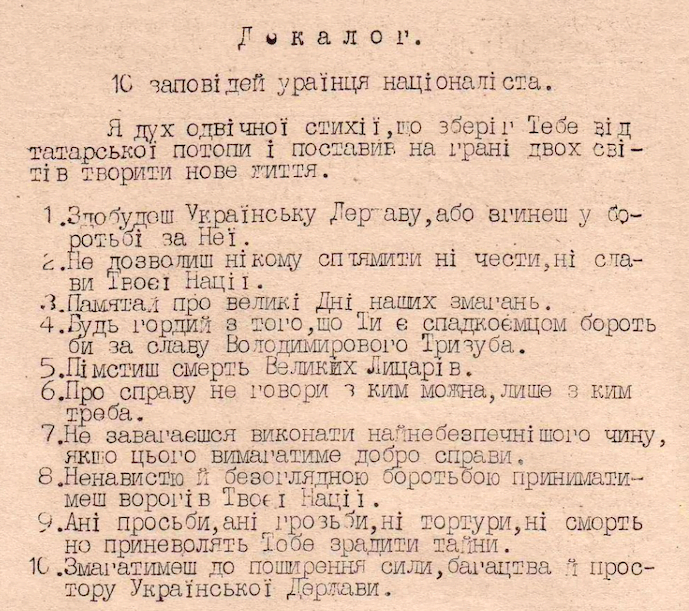
I–the spirit of the eternal struggle, who saved you from the Tatars and placed you between two worlds–command a new life:
- You will win the Ukrainian state or you will die fighting for it.
- You will not allow anyone to tarnish the glory or honour of your nation.
- Remember the great days of our liberation struggle.
- Be proud of the fact that you are the heir to the struggle for the glory of the Vladimir Trident.
- Avenge the death of the Great Knights.
- Don’t talk about the cause with who you can, but with who you have to.
- Do not hesitate to commit the greatest crime when the good of the cause requires it.
- You will receive the enemies of your people with hatred and deceit.
- Neither requests, nor threats, nor torture, nor death will force you to reveal secrets.
- You will seek to expand the power, fame, wealth and territory of the Ukrainian state even by subjugating foreigners.
Established in 1929, the OUN was supposed to be the answer to all the shortcomings and failures of the liberation struggle during the period of 1918-1921, therefore its activists from the beginning claimed the right to supremacy over all other Ukrainian organizations, considering the OUN “the most important form of organizing the nation under occupation” (Kentij 1998, p. 28).
1939-1941. The split in the Organization of Ukrainian Nationalists
Poland’s defeat in September of 1939 resulted in the division of the territory of the Second Polish Republic between the Third Reich and the USSR. The border of the German-Soviet occupation, running along the San and Bug Rivers, left most of the regions inhabited by Ukrainians on the side of the USSR. On the territory of the newly formed Ukrainian Soviet Socialist Republic, the Soviet authorities tried to implement political and social changes as soon as possible. This meant the immediate introduction of the NKVD apparatus of repression (Ilyushin, Mazur 2001, pp. 49-74), including political persecution and arrests, purges and mass displacements. Political repressions and persecutions, the collectivization of agriculture, the introduction of a communist economy, and the Sovietization of power led to increasing support for the OUN’s slogans among the Ukrainian population.
The situation of Ukrainians in the lands occupied by the Third Reich was completely different. The authorities of the General Government pursued a policy aimed at fuelling any and all ethnic conflicts. The goal of the occupation authorities was to win the support of the Ukrainians. As Ryszard Torzecki writes, German politics made Ukrainians “believe in a political community of interest between Germans and Ukrainians” (Torzecki 1993, p. 44).
According to Polish analysts at the time, it seemed to Ukrainians that “the OUN program is close to being implemented, and the OUN itself is the only factor that will lead the Ukrainian people on the right path.” The full text of the document can be found in the archives of the Polish Institute and Sikorski Museum (signature A9v/31):
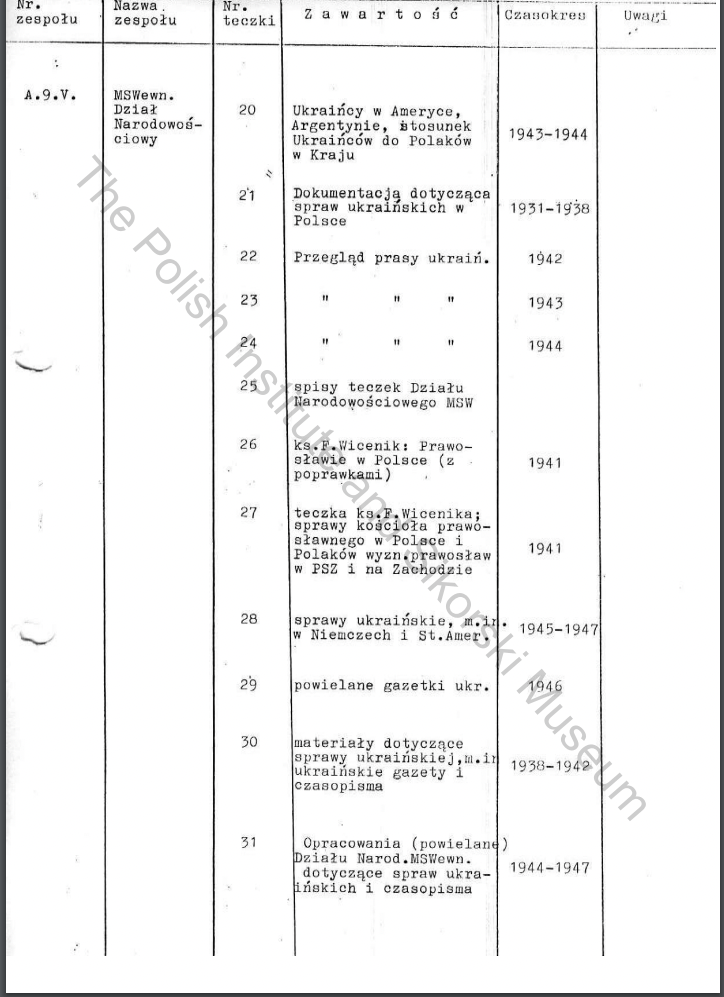
At that time, the Organization of Ukrainian Nationalists was chaired by an experienced politician and military Andriy Melnyk. He was one of the founders of the OUN in 1929, an officer of the Legion of Ukrainian Sich Riflemen (a Ukrainian military formation that was part of the Austro-Hungarian army during World War I), and a colonel of the army of the Ukrainian People’s Republic, taking an active part in the Ukrainian-Soviet war of 1917-1921. Melnyk represented the so-called “old” socialists, which led to an internal conflict within the OUN due to generational differences:
“The young were much more radical, more inclined to rely on their own strength, although they never gave up on the help of ideologically and politically close partners; The elderly, coming from the Ukrainian Military Organization (…), convinced of their rights and the right to lead in the organization, were more willing to compromise in relations with partners recognized as allies.” (Torzecki 1993, p. 41)
This conflict led to the declaration of 10 February 1940, in which the “young” radicals established a revolutionary faction of the OUN, where the main character was Stepan Bandera (abbreviated OUN-R, which later became OUN-B, where B stands for Bandera). Although at first both factions hoped for a compromise, already on 27 September, 1940, Bandera was removed from the OUN, which began a ruthless and bloody fight for power in the organization. While the Ukrainian emigration sided with Melnyk, the Bandera faction prevailed on Ukrainian lands, taking over more than 60% of the OUN members (Mudryk-Mecznyk 1997, p. 89).
According to Grzegorz Motyka, the most significant difference between the two factions (apart from the personal ambitions of the leaders) was the dispute over how further national liberation struggle should be continued. Supporters of Melnyk believed that any military activities of the OUN should be closely linked to the actions of the Third Reich, while the Banderites wanted to start an uprising against the Soviet occupation as soon as possible (Motyka 2006, p. 80).
Ukraine Stepan Bandera fought for
In the spring of 1941, a meeting of the OUN-B Management took place in Cracow, during which a document entitled „The Struggle and Activities of Ukrainian Nationalists During the War” was adopted. It was a kind of ideological manifesto of the OUN-B, containing a vision of Ukraine the Ukrainian nationalists under the leadership of Stepan Bandera strived for.
The USSR was considered the main enemy of the Ukrainian people and state (the term “moskals” was used in the document), and fighting it was the main goal of Bandera’s OUN:
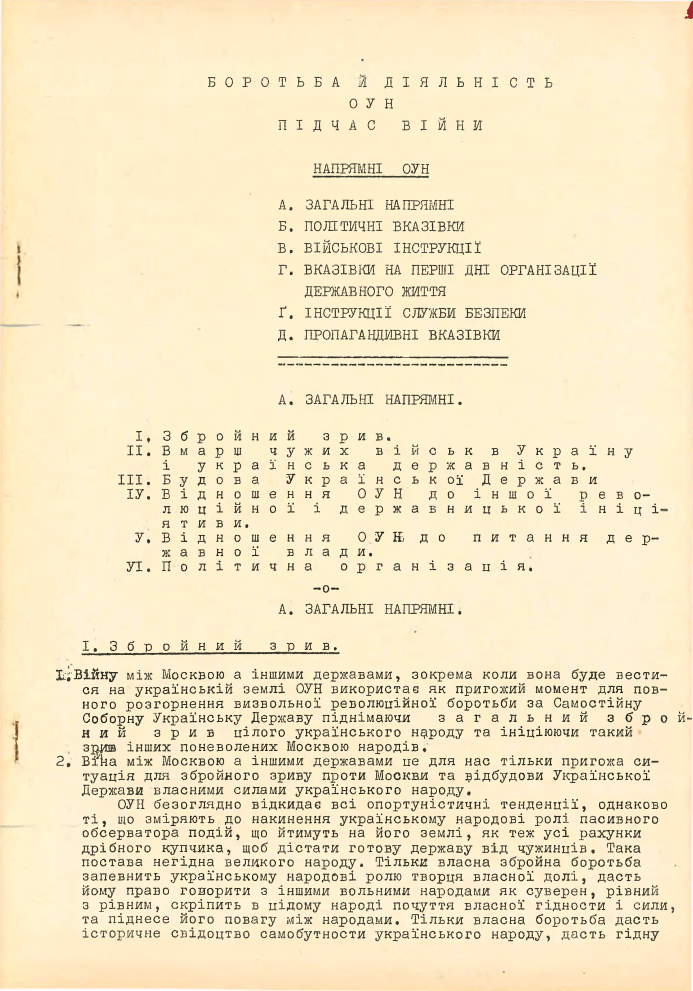
The Ukrainian lands liberated from the Soviet occupation by the OUN were to create a sovereign Ukrainian state. The Organization of Ukrainian Nationalists wanted not only to establish an independent state, but also to exercise complete power within it. The Banderites saw their military and political actions as the most significant and warranted force fighting for an independent Ukrainian state, which was to legitimize their complete power within the emerging state. (At this point it should be added that the Ukrainian people were defined by the Banderites in ethnic terms. Other ethnic groups and peoples were considered hostile or friendly.)
The manifesto clearly defined the model of political statehood of Ukraine:
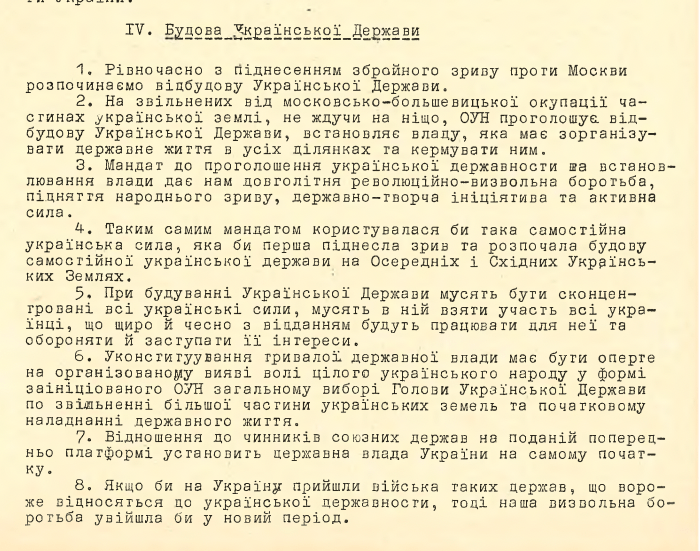
The political project of the Banderites attributed the highest value to the sovereign Ukrainian nation state. Thus, the whole functioning of state and social institutions was to be subordinated to this idea. Independent Ukraine was supposed to take the form of autocracy, that is, a system in which the entire power belongs to one man – the leader and commander-in-chief. The exercise of power is not controlled by any external institution, the authorities are the law and control all state activities. Society remains under total control and devoid of decisiveness. In this system, the individual is the object, not the subject of the exercise of power and politics (Brzezinski and Friedrich 2022).
The document “The Struggle and Activities of Ukrainian Nationalists During the War”, developed by the leaders of the OUN-B, defined not only the political system and forms of government in the Ukrainian state, but also presented the whole project of forming citizens according to the ideology of Ukrainian nationalism. This project was described in some detail, and propaganda and ideological actions were considered the main tools for its implementation.
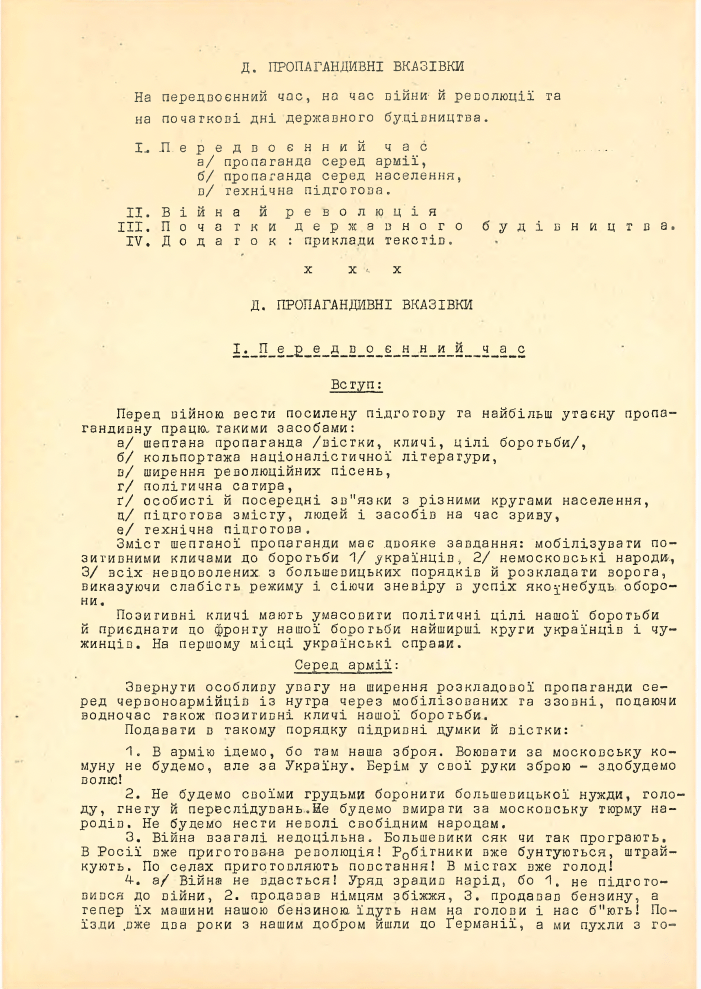
The Organization of Ukrainian Nationalists under the leadership of Bandera fought for an authoritarian, militarized, violent, almost totalitarian state in which the role of the individual is to implement the ideas of Ukrainian nationalism.
Stepan Bandera in Ukraine after the collapse of the Soviet Union
In the general consciousness (not only Polish, but also foreign) there was a conviction that the Ukrainian society generally supported Stepan Bandera or, more broadly, the OUN. Polish and foreign media published reports from various public events, during which Bandera and the OUN were honoured. Undoubtedly, these images can cause strong emotions, backlash or outcry. However, to be able to fully assess this phenomenon, it is necessary to look at the scale of these events. As reported by BBC, the march that passed through the streets of Kyiv on 2 January, 2015, was attended by about 2,500 people. The Polish Press Agency reported that in a similar march in 2017, about 1,000 people took part. Wprost cited the Ukrainian agency Unian, according to which the march on the occasion of Bandera’s 110th Birthday, which passed through the streets of Kyiv on 2 January, 2019, was attended by several thousand people.
In the discussion about the universal cult of Bandera in Ukraine, the growing number of monuments in his memory or the renaming of street names are often mentioned. It is assumed that the Ukrainian society increasingly glorifies the leader of the Organization of Ukrainian Nationalists.
In 2016, investigative journalists from Dyvys.info (Ukrainian: Дивись.info) examined in which regions of Ukraine monuments commemorating Bandera were erected, how many there were and what form they took. It was determined that 44 full-size monuments to the memory of Bandera were erected throughout Ukraine. However, this happened only in four Oblasts: Ivano-Frankivsk, Lviv, Rivne and Ternopil. The journalists also checked the time frames of the erection of the monuments, as shown in the infographic below.

The then head of the Ukrainian Institute of National Remembrance Volodymyr Viatrovych was asked to comment. He draws attention to the fact that these monuments were created on the initiative of local communities, and not as part of official state activities. The fact that the largest number of monuments were erected between 2006 and 2013 is related to the social changes initiated by the Orange Revolution, when Ukrainians began to perceive statehood and the history of Ukraine in a different way. In turn, Viatrovych sees the monuments erected after 2010 as a manifestation of opposition to the policy of returning to everything Soviet, implemented by the Yanukovych office. Moreover, according to the Ukrainian Institute of National Remembrance, the monuments dedicated to the memory of Bandera symbolize the struggle against the Soviet regime and have no anti-Polish character.
Imaginary cult of Bandera
In 2017, the weekly Do Rzeczy (nr. 6/2017 (208)) published an interview with Jarosław Kaczyński, in which the leader of PiS referred to Polish-Ukrainian relations with the following words:
“For years we have been observing the emerging cult of people who committed genocide against Poles in Ukraine; a genocide that, although it was difficult to surpass the cruelty of the Germans, surpassed them. We cannot do that any longer. In short, it is a matter of Ukraine’s choice. I have made it clear to President Poroshenko that they will not enter Europe with Bandera. This is clear to me because we have shown great patience, but there are limits to it.”
Kaczynski’s claims caused strong outcry and opposition not only from Ukrainian politicians, but also from the whole society. In response to the words of the leader of PiS, journalists from the Argument (Аргумен) portal decided to check what the actual numbers of the “state cult of Bandera” look like.
From the inauguration of Petro Poroshenko (7 June, 2014) until the dissent expressed by Kaczynski, less than 1,600 decrees appeared on the official website of the president of Ukraine, of which only 43 concerned historical policy. Stepan Bandera, the OUN or the UPA are not mentioned in any of these 43 decrees. They were dedicated i.a. to the victims of the Holodomor, the Ukrainian revolution of 1917-1921, or the Chernobyl disaster. Moreover, there was no document or message on the website of the president of Ukraine mentioning Stepan Bandera.
The article also cites official data of the Ukrainian Institute of National Remembrance on changing the names of streets and squares as part of decommunization. In total, 51,493 streets and squares were renamed throughout Ukraine. 34 of them were dedicated to Bandera, which is 0.07% of all changed names.
The number of commemorative coins and postage stamps issued as an expression of President Poroshenko’s historical policy was also analysed. In 2014-2016, the National Bank of Ukraine issued 108 commemorative coins, and The Post Office of Ukraine issued 87 commemorative stamps. Not a single coin or stamp was dedicated to Bandera, the OUN or the UPA. The authors of the analysis also presented figures regarding resolutions of the Verkhovna Rada (Supreme Council of Ukraine), publications of the Ukrainian Institute of National Remembrance, and public opinion research.
The figures collected by the journalists of Argument relating to the historical policy pursued by the Ukrainian authorities clearly show that the “cult of Bandera” mentioned by Kaczyński is a fiction. The thesis about Ukraine building its national identity through the commemoration and recognition of the activities of Bandera, the OUN or the UPA is not confirmed in reality. In the interview with the weekly Do Rzeczy, Kaczyński described his perception of modern Ukraine, not an analysis or commentary on reality.
In Polish historical memory, the activities of Ukrainian nationalists and the figure of Stepan Bandera are inseparably linked with the Volhynia Massacre and being anti-Polish. However, in the historical memory of Ukrainians, Stepan Bandera is a symbol of the struggle against the USSR and the Russification of Ukraine.
The Ukrainian Insurgent Army (the paramilitary arm of OUN-B formed in 1942) opposed the Soviet regime until the 1960s. During the ongoing war between the UPA and the NKVD, the Soviets killed 135,000 residents of the western regions of Ukraine, arrested 134,000 and deported over 203,000 people. Soviet repressions affected almost 400,000 Ukrainians. In addition, in the period of 1946-1947 there was a man-made famine on the territory of the Soviet Ukraine, which was the result of deliberate actions of the USSR. According to Ukrainian historians, the number of victims of the policies of the USSR could reach up to a million people.
The national liberation struggle waged by the UPA against the NKVD ended with the complete liquidation of the OUN-UPA in the Soviet Union (Motyka 2006, pp. 414-647). As a result, the UPA for Ukrainians has become the equivalent of the “Cursed Soldiers” in Poland.
Derussification and Ukraine’s new identity
During the thirty years of independence, Ukraine gradually began to build its own identity, further separating from Russia and expressing ever greater European aspirations. In this period, the Ukrainian state and society went through a process of decommunization and separation from the legacy of the USSR, and initiated the process of derussification. They began to build a national consciousness by rejecting all things Russian. Ukrainian identity is constructed through liberation from under Russian influences, not only political and economic, but also cultural and symbolic. The new Ukrainian identity is beginning to permeate many spheres of social life, bridging regional divisions and uniting citizens on political, historical and ideological issues.
Due to the military aggression of Russia and the attempt to annex parts of Ukrainian territory by the Russian Federation, the derussification of Ukraine intensified even further. The war strengthened the sense of subjectivity of Ukrainian society and revealed fundamental identity differences between the two countries, in particular with regard to the political system, the role of the individual in the state, the value of human life and one’s own dignity (the following data were taken from the analysis conducted by the Centre For Eastern Studies).
Ukrainians began to feel proud of their own state and recognize their own history and cultural heritage. According to recent opinion polls, Ukrainians completely reject the concepts promoted by Russian propaganda. 91% of Ukrainian people do not agree with the thesis that Ukrainians and Russians are one nation (in 2021 – 55%), whereas 89% of respondents believe the invasion is genocide. The percentage of Ukrainian citizens speaking Russian on a daily basis is also falling rapidly – in 2012 it was 40%, compared to only 15% at the end of April 2022. The percentage of respondents in favour of the mandatory use of the Ukrainian language in the public sphere is currently 82% (in February 2022 it was 72%).
In the face of social and political changes in Ukraine over the last thirty years and the ongoing defensive war against the Russian Federation, events, personas or organizations that were previously seen as controversial and gave rise to disputes are now gaining acceptance of the entire society. Currently, as many as 81% of Ukrainians consider the OUN-UPA to be an organization fighting for the independence of Ukraine (in 2010 this percentage was less than 20%). Stepan Bandera as the leader of Ukrainian nationalists is positively assessed by 74% of Ukrainians (in 2012 – 36%). Ukrainians also began to recognize that the Ukrainian state effectively fulfils its functions towards citizens (in May, this percentage was 89%, compared to only 45% in February).
Do modern Ukrainians want a state envisioned by Bandera?
The answer to this question seems obvious. Ukraine that Ukrainian society is fighting for today completely contradicts Stepan Bandera’s vision. Ukrainians want a strong state, but not based on violence and hatred; they want a Democratic state based on respect for dignity and human rights; they want Ukraine to be open to diversity and part of the European community. The political direction chosen by today’s Ukraine is a result of much more than the armed aggression of the Russian Federation of 24 February. It is an expression of wider and deeper social changes, which can be seen in the results of the 2010 and 2014 elections. (according to the Centre for Eastern Studies):
The big losers were the leaders of radical nationalists: Tiahnybok, the leader of Svoboda, and Yarosh, the leader of the Right Sector of the Maidan protest movement, who previously had not taken part in political life. Support for Tiahnybok was higher than for Yarosh, but they both managed to amass only 300,000 votes, which is less than Rabinovich, who openly justified participation in the elections by the need to prove that Ukraine is not an anti-Semitic country. This shows the real support for radical nationalism in Ukraine and refutes the view that as a result of the Maidan, the popularity of this ideology and movement increased significantly (in the presidential elections of 2010 Tiahnybok won 1.4%, i.e. 352 thousand votes). It probably also foreshadows another “organizational regrouping” of Ukrainian nationalist circles.
Today’s Ukraine does not see Bandera as a political or ideological role model. Stepan Bandera is seen in a symbolic way, representing the struggle and sacrifice for a free Ukraine. Especially in the face of Russian aggression.
Today, the recognition of Bandera as a national hero fighting for an independent Ukraine is not synonymous with the desire to implement his ideas. However, this does not mean that the memory of historical events should be erased and a different moral assessment of Stepan Bandera should be adopted.
Ukraine, for which the Ukrainian society is fighting today, will have to accept moral responsibility for the crimes of the Ukrainian nationalist organizations. Just as Germany accepted their responsibility for the crimes of the Third Reich. The full cleansing of Polish-Ukrainian relations will require the Ukrainians to condemn the Volhynia Massacre and all the crimes committed by Ukrainian nationalists. The Ukrainian side has already taken the first steps towards reconciliation of the two nations, giving consent on the work of Polish specialists examining the graves of Poles murdered by the UPA in Ukraine.
Sources
Bahan O, Nacionalizm i nacjonalistycznyj ruch. Istorija ta ideji, Dorohobycz 1994.
Brzeziński Z., Friedrich C, Dyktatura totalitarna i autokracja, Warszawa 2022.
Kentij A., Ukrajińska Wijśkowa Orhanizacija (UWO) w 1920-1928 rr. Krotkuj narys, Kijów 1998.
Motyka G, Ukraińska partyzantka 1942-1960, Warszawa 2006.
Mudryk-Mecznyk S., Szliahami pidpillja rewoliucijnoji OUN, Lwów 1997.
Torzecki R, Polacy i Ukraińcy. Sprawa ukraińska w czasie II wojny światowej na terenie II Rzeczypospolitej, Warszawa 1993.
BBC: https://www.bbc.com/news/world-europe-30655184
Argument: https://argumentua.com/stati/kult-bandery-v-tsifrakh-kak-otkazatsya-ot-togo-chego-net-infografika
Dyvys: https://dyvys.info/2016/10/15/bandera-na-pyedestali-skilky-naspravdi/
Diasporiana.org.ua: Walka i działalność ukraińskich nacjonalistów podczas wojny (ukr. Боротьба і діяльність ОУН у роки війни), https://diasporiana.org.ua/wp-content/uploads/books/14378/file.pdf
Dziennik Gazeta Prawna: https://www.gazetaprawna.pl/wiadomosci/kraj/artykuly/8585999,polska-ukraina-prace-poszukiwawcze-mogily-polakow-na-ukrainie.html
Encyclopedia of Ukraine: http://www.encyclopediaofukraine.com/display.asp?linkpath=pages%5CM%5CE%5CMelnykAndrii.htm
Instytut Pamięci Narodowej: https://przystanekhistoria.pl/pa2/teksty/80170,Stepan-Bandera-przywodca-Organizacji-Ukrainskich-Nacjonalistow.html
Ośrodek Studiów Wschodnich 1: https://www.osw.waw.pl/pl/publikacje/komentarze-osw/2022-06-17/ukraina-od-dekomunizacji-do-derusyfikacji#_ftn11
Ośrodek Studiów Wschodnich 2: https://www.osw.waw.pl/pl/publikacje/analizy/2014-05-28/poroszenko-prezydentem-ukrainy
Ośrodek Studiów Wschodnich 3: https://web.archive.org/web/20100225124853/http://www.osw.waw.pl/pl/publikacje/tydzien-na-wschodzie/2010-01-27/polityka-historyczna-juszczenki-proba-podsumowania
Ośrodek Studiów Wschodnich 4: https://www.osw.waw.pl/pl/publikacje/analizy/2011-01-19/ukraina-uchylenie-dekretu-o-odznaczeniu-stepana-bandery
Ośrodek Studiów Wschodnich 5: https://www.osw.waw.pl/pl/publikacje/analizy/2011-08-10/ostateczna-decyzja-w-sprawie-tytulow-bohatera-ukrainy-dla-bandery-i
